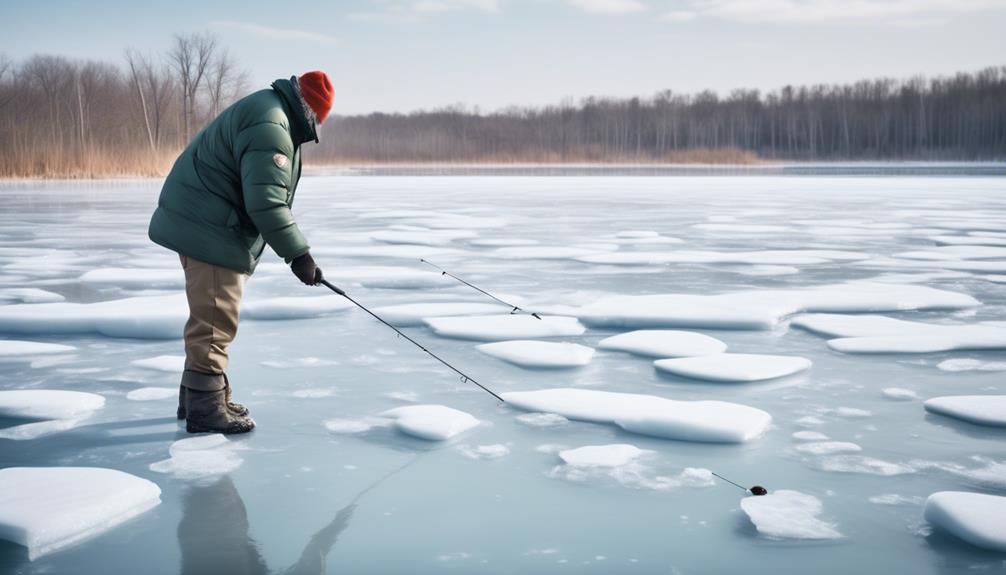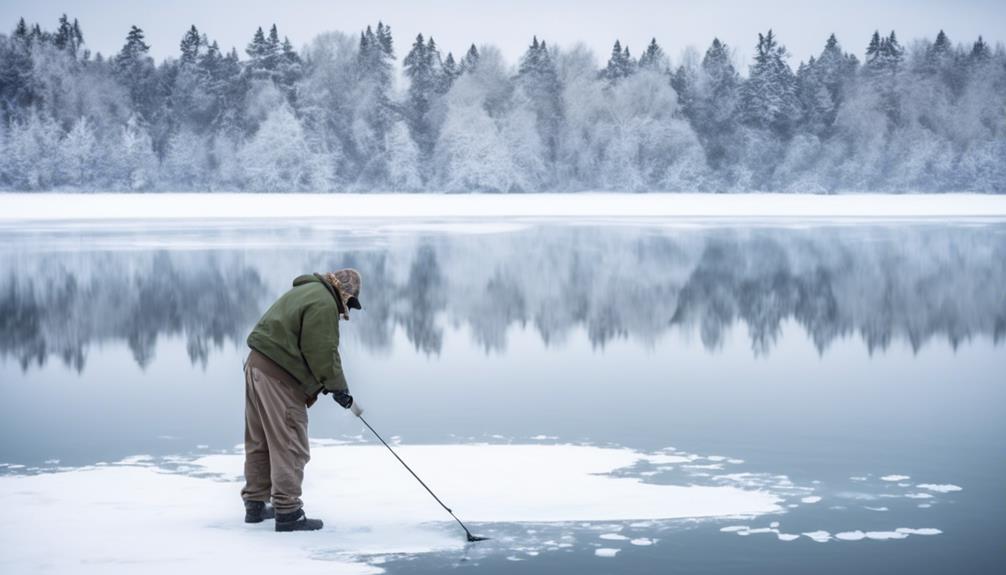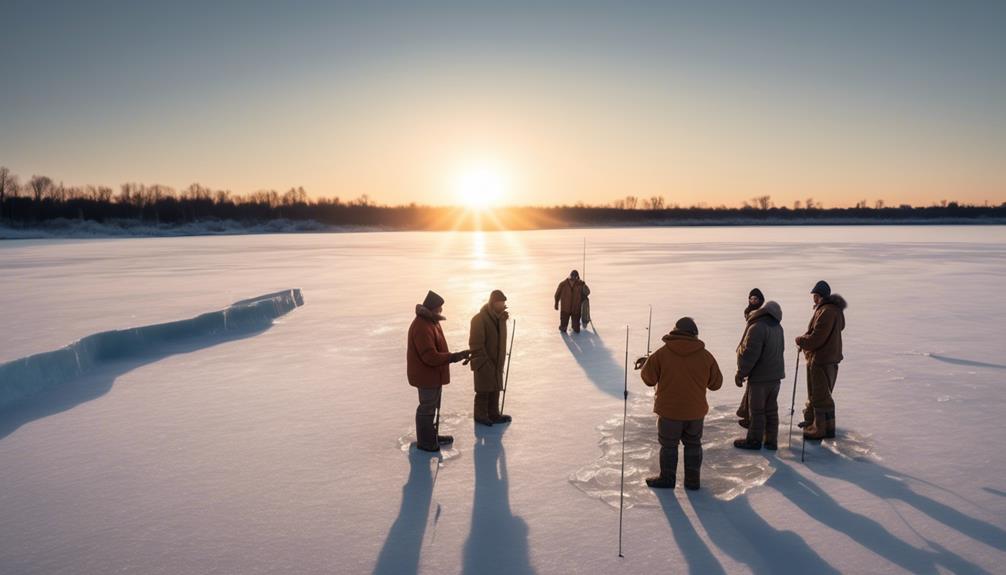So, you've decided to head out to your favorite shallow water ice fishing spot in search of some panfish. As you prepare your gear and set out onto the ice, you may find yourself wondering about the best techniques to use in this specific scenario.
From understanding panfish behavior in shallow waters to mastering the art of hole placement on shallow ice, there are several key techniques that can greatly improve your chances of a successful catch.
Stick around to uncover these valuable insights and take your shallow water ice fishing game to the next level.
Understanding Panfish Behavior in Shallow Waters
To successfully catch panfish in shallow waters, understanding their behavior is crucial. Panfish feeding habits are influenced by the structure of shallow waters. Panfish are known to feed near vegetation, fallen trees, rocks, and other types of structure. These structures provide shelter for smaller baitfish and insects, which panfish prey upon. By understanding this behavior, you can effectively locate and target panfish in shallow waters.
When panfish are feeding in shallow waters, they tend to be more active during specific times of the day. Early morning and late afternoon are prime times for panfish to be actively feeding. During these periods, panfish move closer to the shallows to hunt for food. Understanding this behavior allows you to plan your ice fishing trips accordingly, increasing your chances of a successful catch.
Shallow water structure plays a vital role in panfish behavior. Panfish often use the cover provided by shallow water structures to hide from predators and ambush their prey. Fallen trees and submerged vegetation are popular spots for panfish to hide and feed. By identifying these structures, you can strategically position yourself to target panfish more effectively.
Choosing the Right Gear for Shallow Water Panfishing
When panfishing in shallow waters, selecting the appropriate gear is essential for maximizing your chances of a successful catch. One crucial factor to consider is the thickness of the ice. For shallow water panfishing, it's recommended to use gear suitable for thinner ice. This means using augers or drills with shorter blades to bore through the ice efficiently and safely. Additionally, ensure that your ice fishing shelter is lightweight and easy to transport, as it will be set up over shallower depths.
Another important aspect of choosing the right gear for shallow water panfishing is gear maintenance. Since shallow water panfishing often requires maneuvering through tighter spaces, it's essential to keep your equipment in top condition. Regularly check and maintain your ice fishing auger, shelter, and other gear to ensure they're in good working order. This includes sharpening blades, checking for any damages, and lubricating moving parts. Proper maintenance not only extends the lifespan of your gear but also ensures a smoother and more efficient fishing experience.
When it comes to rod and reel selection, opt for lightweight options that are sensitive enough to detect bites in shallow water. A shorter fishing rod can also be advantageous in tight spaces. Additionally, utilizing small, light jigs and bait is recommended for shallow water panfishing. These can be more maneuverable and effective in targeting panfish in these environments.
Identifying Ideal Locations for Shallow Water Panfish
Considering the gear you've selected for shallow water panfishing, pinpointing ideal locations becomes crucial for maximizing your catch. To identify the best spots for shallow water panfish, take into account the following factors:
- Ice Thickness: Ensure that the ice is thick enough to support your weight and the weight of your gear. Shallow waters may have varying ice thickness, so use an ice auger to drill test holes as you move across the ice. A safe ice thickness for a single angler is generally considered to be at least 4 inches, while for a group, it should be at least 5-6 inches.
- Underwater Structures: Look for signs of underwater structures such as submerged trees, weed beds, or drop-offs. These areas often attract panfish as they provide shelter and a steady food supply. Drill test holes near these structures to find the best fishing spots.
- Weather Conditions: Keep an eye on the weather conditions, as they can greatly impact the behavior of panfish. Warmer, sunny days may lead panfish to move towards shallower waters, while cold fronts may push them into deeper areas. Understanding how weather influences fish behavior can help you pinpoint the best locations.
Mastering the Art of Hole Placement on Shallow Ice
Optimize your shallow water ice fishing success by strategically positioning your holes on the ice. When it comes to shallow water ice fishing for panfish, mastering the art of hole placement is crucial for a productive outing. Start by considering ice thickness and weather conditions to ensure a safe and successful fishing experience.
Before drilling any holes, always assess the ice thickness. For shallow water fishing, aim for ice that's at least 4 inches thick. Use an ice auger to drill test holes as you move towards your desired fishing location. Be cautious of areas with varying thickness due to factors such as currents or springs. Once you find suitable ice, start planning your hole placements.
Weather conditions play a significant role in hole placement on shallow ice. If the weather has been consistently cold, the ice is likely more stable, allowing you to spread out your holes. However, if there have been fluctuations in temperature, it's essential to concentrate your holes in a smaller area to ensure safety. Additionally, consider the direction of the wind. Placing your holes on the windward side can help prevent the buildup of drifting snow, keeping your fishing spots clear and visible.
As you master the art of hole placement on shallow ice, always prioritize safety. By considering ice thickness and weather conditions, you can strategically position your holes for a successful and enjoyable shallow water ice fishing experience.
Perfecting Bait and Lure Selection for Shallow Ice Panfish
To maximize your success in shallow water ice fishing for panfish, carefully select the most effective bait and lures to entice your target species. The right bait presentation and lure retrieval can make a significant difference in your catch rate.
Here are some key tips to help you perfect your bait and lure selection:
- Bait Presentation: When fishing in shallow ice, it's crucial to present your bait in a natural and enticing manner. Panfish are often attracted to small, natural-looking baits such as waxworms, maggots, or tiny jigs tipped with bait. Consider using light tackle and subtle movements to mimic the natural movements of insects or small aquatic creatures. Experiment with different depths and motions to find the most effective presentation for the specific panfish species you're targeting.
- Lure Retrieval: Selecting the right lures and mastering their retrieval is essential for shallow water ice fishing success. Small jigs, spoons, or soft plastics can be highly effective for panfish. Pay attention to the speed and rhythm of your lure retrieval. In colder water, panfish may be less active, so a slower and more subtle retrieval technique might be necessary to entice them to strike. Additionally, using brightly colored lures or those with added flash can help attract the attention of panfish in the clear waters of shallow ice fishing spots.
Techniques for Attracting Panfish in Shallow Ice
For successful panfish ice fishing in shallow waters, employ varied bait presentation and retrieval techniques based on the particular species you aim to attract. Panfish, such as bluegill and sunfish, are attracted to movement and may respond well to small jigs or spoons tipped with bait. Experiment with different jigging motions to mimic the natural movements of their prey. For instance, try gently lifting and dropping the bait to entice a bite. If the ice is relatively thin, creating minimal disturbance is essential to avoid spooking the fish. On the other hand, in thicker ice, you may be able to use more aggressive jigging techniques. Keep in mind that panfish are often found in schools, so once you've located one, there are likely more nearby.
In terms of weather conditions, panfish tend to be more active during low-light periods, such as early morning or late afternoon. During overcast days, they may venture shallower than usual. Pay attention to these patterns and adjust your fishing approach accordingly. When the sun is bright, panfish might seek shade or cover provided by docks, overhanging trees, or other structures. Position yourself strategically to take advantage of these natural hiding spots.
Additionally, using brightly colored baits or lures can be effective in murky or dark water conditions. By adapting your techniques to the specific ice thickness and weather conditions, you can significantly improve your chances of attracting panfish in shallow ice.
Navigating Shallow Ice Fishing Challenges

Navigating shallow ice fishing challenges requires adapting your techniques to the specific conditions, such as ice thickness and weather patterns, in order to effectively attract panfish. When dealing with shallow water panfish habitat, it's important to consider the following:
- Understanding Ice Thickness: Shallow water often results in variable ice thickness. Be cautious and test the ice thickness frequently, especially when fishing near shallows.
- Utilizing Lighter Equipment: Shallow waters can limit the use of heavy equipment. Opt for lighter ice fishing rods and lines to prevent scaring off panfish and to navigate through tighter spaces.
- Adapting to Weather Patterns: Shallow waters are more susceptible to temperature changes. Stay updated on weather patterns and adjust your fishing strategy accordingly to ensure the safety of the ice and to attract panfish successfully.
In shallow water panfish habitat, it's essential to be mindful of the depth and the fragility of the ice. Additionally, consider the ice fishing equipment restrictions that come with shallow waters. Adapting to these challenges will increase your chances of a successful ice fishing experience while ensuring the safety of both yourself and the panfish.
Safety Tips for Shallow Water Ice Panfishing
When ice fishing in shallow water for panfish, prioritize safety by regularly assessing the ice thickness and potential hazards in the surrounding area.
Ice thickness is crucial for your safety. Before venturing onto the ice, ensure it's at least 4 inches thick, as recommended for a single person. For larger groups or vehicles, the ice should be even thicker. Always bring an ice spud bar to check the ice thickness as you move, tapping ahead of you to ensure it's safe.
In addition to monitoring the ice, it's important to be prepared for emergencies. Pack essential safety gear such as ice picks, a throw rope, and a flotation device. These items could save your life in the event of an accidental fall through the ice. Furthermore, wearing a buoyant ice fishing suit adds an extra layer of protection.
It's also wise to inform someone of your plans, including your expected return time and location. This way, if something goes wrong, help can be sent promptly.
Lastly, stay updated on the weather forecast and be cautious of any sudden changes in temperature, as these can affect ice stability.
Frequently Asked Questions
Can You Use a Fish Finder to Locate Panfish in Shallow Waters While Ice Fishing?
Yes, you can use a fish finder to locate panfish in shallow waters while ice fishing. Using underwater cameras and ice fishing gear for shallow water panfish fishing can also be helpful in finding and catching panfish.
What Are Some Tips for Keeping Your Ice Fishing Hole From Freezing Over in Shallow Water?
To prevent freezing your ice fishing hole in shallow water, keep your gear and hole clear of snow and slush. Use a bait that suits the panfish in the area. Check your equipment regularly to ensure it's functioning properly.
Are There Any Specific Techniques for Catching Larger Panfish in Shallow Waters Compared to Deeper Waters?
In shallow waters, for larger panfish, bait selection and rod and reel choice are crucial. Opt for smaller jigs or spoons to entice them. Use a light to ultralight rod and reel combo for better sensitivity and control.
How Do You Know When It's Safe to Walk on Shallow Ice for Panfishing?
Before walking on shallow ice for panfishing, check the ice thickness and conditions. Always take safety precautions and use proper gear like ice picks and a life jacket. Remember, safety comes first when ice fishing.
What Are Some Common Mistakes to Avoid When Ice Fishing for Panfish in Shallow Waters?
When ice fishing for panfish in shallow waters, common mistakes to avoid include using improper equipment, not making technique adjustments for the depth, and selecting the wrong bait. Proper equipment, technique adjustments, and bait selection are crucial.
Conclusion
Now that you've learned the best techniques for shallow water ice fishing for panfish, you're ready to hit the ice and reel in some big catches.
Remember to understand panfish behavior, choose the right gear, identify ideal locations, master hole placement, perfect bait and lure selection, and use techniques to attract panfish.
Be sure to navigate fishing challenges and prioritize safety for a successful and enjoyable ice fishing experience.
Happy fishing!



